the history of yeovil's pubs
PUBS HOME PAGE |
PUBS INTRODUCTION |
PUBS BY NAME |
BEERHOUSES |
george inn / hotel (2)
108 Middle Street
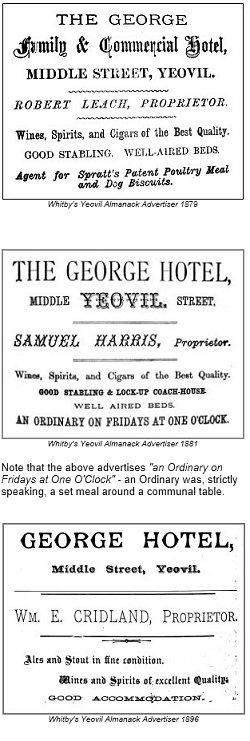 The
George Inn
(shown as 'D' on
the map below)
began life as a
private
dwelling, built
during the
1400’s and from
1478 it was
owned (among
other licensed
premises) by the
Trustees of
Woborn's
Almshouse, who
continued to own
it until 1920
with the rent of
the building
providing a
regular income
for the
Almshouse.
The
George Inn
(shown as 'D' on
the map below)
began life as a
private
dwelling, built
during the
1400’s and from
1478 it was
owned (among
other licensed
premises) by the
Trustees of
Woborn's
Almshouse, who
continued to own
it until 1920
with the rent of
the building
providing a
regular income
for the
Almshouse.
It may be that the name "The George" derived from the founder's dedication of the Almshouse to 'the honour of St George and St Christopher, the martyrs'. Until the 20th century almsmen of the foundation wore a red cross on their left breast in honour of St George the Martyr. Nevertheless the George was originally, at least from 1550, called the Three Cups Inn, there already being a George Inn in High Street. It would appear that the Three Cups was renamed the George around 1720.
In 1618 an order was made that only nine licensed premises be allowed in the borough (that is the town, not that part of High Street today called the Borough) and two outside, with the rest being 'suppressed'. The Three Cups was probably one of the nine 'allowed' premises.
The George was a timber-framed building over low stone walls with a jettied (upper floor projecting beyond the dimensions of the floor below) upper storey in the style of a Wealden house. Indeed the George was regarded as the most westerly example of this style of domestic architecture usually found in the southeast of England (the term Wealden derives from the Weald of Kent). The form consists of a central hall open to the roof with jettied bays of two storeys at either end. Around the time the building became a tavern, in the mid-15th Century, a new floor was inserted in the great hall, making rooms on the new first floor.
It is worth repeating here an extract from the proceedings of the Yeovil Archaeological and Local History Society of 1965 entitled 'The George Hotel, Yeovil, Somerset' by LC Hayward and RW McDowell -
|
"The George has for three hundred years served as a small inn, never even rising to the rank of a coaching inn. Yet it began as a 15th century dwelling house and, because it was owned by the Woborn's Almshouse Trustees from 1478 to 1920, its history can be traced in their records. Writing in the Proceedings for 1930, Mr John Goodchild identified The George as "the tenement in Pyt Lane" (now Middle Street) valued at 6/8d a year, one of three in that street recorded as Almshouse property in a list printed in the Charity Commissioners' Report. This list (now missing) was drawn up in 1502 by William Skarre, procurator domus elemosinariae de Yevele, and it included 14 tenements in Yeovil and Stoford, which are also mentioned in Letters Patent dated 25 November 1478, confirming the grant of these properties to the newly founded Woborn Almshouse. Rents for these tenements appear in extant 16th century Account Rolls (now deposited in the Somerset Record Office), and it is reasonable to suppose that the tenements had remained continuously in the hands of the Almshouse Trustees after its foundation in 1478. The largest of these properties in Pyt Lane, valued in 1502 at 6/8d a year, was held in 1531 by William Shorte at a rent of 14/- a year. A lease of 1550 records the grant of a burgage at the same rent to Gyles Hayne for a term of 60 years. The document is endorsed "lease of my dwelling house in Pyt Lane". The increase in rent may well be explained by the addition of the south wing. There is no reason to doubt that Gyles Hayne's dwelling house was already standing in 1478, and this is consistent with its architectural features. Gyles Hayne retained his lease till his death in 1580, he acted as churchwarden in 1561 and 1562, was rated to provide one light horseman in the muster roll, supplied timber and tiles to the churchwardens and was mourned by his widow Alice "with all the bells" at a cost of 3/4d. She continued paying rent for the house until 1597 when John Hacker became the tenant; three years later Joseph Hayne was the tenant, renewing his lease in 1602 "in consideration of a fine of 40/- of lawful money of England" for a term of 60 years. (This lease is also endorsed "my house in Pyt Lane".) An enquiry into the conduct of Almshouse business in 1610 roundly condemned this and several other leases as contrary to the foundation charter, which expressly forbade leases for more than 7 years. Hayne's fine, it was stated, ought to have been £30. The next tenant, the widow Harrison, was followed by Thomas Grobham in 1617. When he renewed his lease for a term of 99 years (or three lives) in 1621, the rent was raised from 14/- to 16/- a year, an increase which probably reflects the addition of new chambers by the division of the hall into two storeys. Thomas Grobham, born in 1586, became a mercer, and was licensed to sell tobacco in 1634, on his death in 1642, his daughter Anne who had married Joseph Underwood, a grocer of Dorchester, inherited his interest, sub-letting the house to Robert Butt, as appears from a lease "dated in the year of our Lord God according to the computation of the Church of England 1650". By this lease Anne Underwood surrendered her interest to her son and daughter, Frederick and Rachell Underwood for a fine of £14; the burgage is described as "formerly held by Thomas Grobham deceased and commonly called The Three Cuppes." The Grobhams were a well-to-do family, two of whom served as portreeve of Yeovil and warden of the Almshouse. It is likely that the house in Pyt Lane first became an inn when Robert Butt became tenant some time after Thomas Grobham's death. Its identification with the Hayne's house is made certain by the description "a burgage in Pyt Lane lying between the lands of Ambrose Locke on the east and George Marchaunte on the west" (Hayne's lease of 1602). "... of Ambrose Locke on the east and Lawrence Woodham the elder on the west" (Grobham's lease of 1621), and "...of the late Ambrose Locke on the east and of Lawrence Woodham on the west" (Butt's lease of 1650). At this period one or both of the additional doorways in the north front may have been inserted. James Markes, who followed as lessee in 1668, is described as an innholder in his renewal lease of 1677; on his death in 1698, The Three Cuppes was rented for 7 years by his son James, and then by Mrs Dorothy Markes until at least 1733. [Note: In his will of 1736 (proved in 1741), Jeremiah Hayne wrote "... Item all that my Tenement or Dwelling House with the appurtenances called the three Cuppes scituate lying and being in Middle Street in the Burrough of Yeovill aforesaid I hereby give bequeath Limit and appoint unto my said Wife Hannah Hayne and her assigns for and During so many years and so much of my Estate Term of Years and Interest of and in the same as she shall happen to live and from and after her Death Then to my said Nephew Giles Hayne for and during so many years of my Estate Tern of Years and Interest therein as he shall from thenceforth happen to Live and after his decease Then to all and Every the Child and children of my said Nephew Giles Hayne equally to be divided and parted between them if more than one share and share alike and to his her and their Executors Administrators and assigns for and during all the residue and remainder of my Estate Term of Years and Interest which shall be therein then to come and unexpired ...". From 1741 [probably 1736 - see note above] the inn was occupied by the Hayne family until a new lease for 99 years at the 17th century rent of 16/- a year was engrossed in 1777 for Hugh Butts, a glover, on the lives of his daughter Mary and the two daughters of Giles Hayne, Elizabeth and Hellena; he paid a fine of £5 on surrendering his previous lease. The inn was then described as "a burgage in Pitt Lane or Middle Street", an early use of the present street name. From 1796, the account book lists Mrs Kitson as paying 16/- rent "for Haynes" , she also rented The Pall Inn, another Almshouse property, so named because a pall belonging to the Woborn Trustees was kept there as the inn adjoined the Almshouse. This pall could be hired out for use at funerals, as was done at the death of Martin Strong, vicar of Yeovil, in 1720. In 1832 an entry in the account book runs "Mr John Thomas paid 207 days rent of the George Inn (late Kitson's) which fell in hand Aug. 30, 1832". From 1841 the name The George Inn is normally used in the list if rents, although payments "for work done at The George" occur as early as 1820; the change of name probably indicates a loyal compliment to King George III, whose portrait, crudely painted in the present century, formed the inn-sign in recent times. John Thomas paid a rack rent of £57 from 1832 to 1834, but the amount fell to £25 in 1849 and stayed at that figure until 1858, despite re-thatching and other work done in 1838, 1847 and 1851. A date stone inscribed "R.T. Custos 1847" showed from its position behind the building that the work done in Robert Tucker's year of office included the repair of the west wall of the yard. One of the tenants during the period of decline was Edmund Henning, who carried on a brewery in Hendford. Then its value rose steadily until the owner of the Osborne Brewery took over the lease; he was Earle Vincent, carrying on business in Sherborne Road where Messrs. Sparrow's Osborne Garage now stands. During his tenancy and that of his successors, J.D. Knight and W.H. Baxter, the rent rose to £92.15.0. a year. The last chapter in its history began in 1920 when Messrs. Lovibond, the Salisbury brewers, purchased the building for £2,500, and while preserving the exterior, made many alterations inside." |
So, therefore, it appears that the building became an inn called the Three Cups (three cups being the arms of the Worshipful Company of Salters) in 1642. Two years later it is alleged that a traveller suffering from the plague stayed at the Three Cups and the resulting epidemic devastated the population of the town. It would also appear that the Three Cups was renamed the George Inn in the early nineteenth century, probably shortly after the original George Inn in High Street closed around 1826.
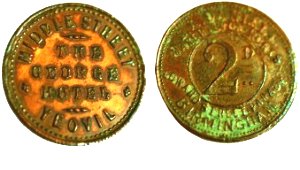 At left
are a
couple of public house
'checks' or trade
tokens issued at
the George Hotel.
The date of the
upper token is
unknown but the
lower token was
issued in the
time when Robert
Leach was
landlord, thus
dating it to
1879-80. They
were made of
copper, and were
23.8mm in
diameter and
with a milled
edge. On the
obverse of the
upper check it
At left
are a
couple of public house
'checks' or trade
tokens issued at
the George Hotel.
The date of the
upper token is
unknown but the
lower token was
issued in the
time when Robert
Leach was
landlord, thus
dating it to
1879-80. They
were made of
copper, and were
23.8mm in
diameter and
with a milled
edge. On the
obverse of the
upper check it
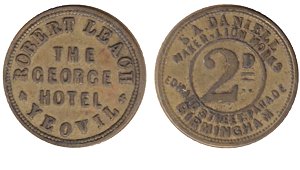 says
"MIDDLE STREET -
THE GEORGE HOTEL
- YEOVIL" and on
the obverse of
the lower
example it reads
"ROBERT LEACH -
THE GEORGE HOTEL
- YEOVIL" the reverse
of both are
identical and
carry
the maker's name
"S.A. DANIELL
MAKER - LION
WORKS EDWARD
STREET PARADE -
BIRMINGHAM" and
the checks'
value - 2D. At
this time two
old pence could
buy you a pint
of stout. Checks
were frequently
used in games,
such as skittles
or quoits where,
for instance,
players would
'chip in' a
check to the
'kitty' which
would be won by
the winning team
to redeem at the
bar. By issuing
checks a
landlord could
guarantee they
would be spent
in his
establishment
only.
says
"MIDDLE STREET -
THE GEORGE HOTEL
- YEOVIL" and on
the obverse of
the lower
example it reads
"ROBERT LEACH -
THE GEORGE HOTEL
- YEOVIL" the reverse
of both are
identical and
carry
the maker's name
"S.A. DANIELL
MAKER - LION
WORKS EDWARD
STREET PARADE -
BIRMINGHAM" and
the checks'
value - 2D. At
this time two
old pence could
buy you a pint
of stout. Checks
were frequently
used in games,
such as skittles
or quoits where,
for instance,
players would
'chip in' a
check to the
'kitty' which
would be won by
the winning team
to redeem at the
bar. By issuing
checks a
landlord could
guarantee they
would be spent
in his
establishment
only.
By the 1890s the George Hotel was a tied house of the Royal Osborne Brewery, with a long lease owned by Earle Vincent. When Vincent died in 1893 his estate was sold off the following year which included "the George Hotel.... let to Mr Thomas Delamont at £35 a year (about £3,500 at today's value)."
The demise of the George, the last remaining secular medieval building in the town, appears to be a sorry tale indeed although the facts are invariably unknown by most people who decry its passing. That the George was wantonly and summarily destroyed by the council is a widely-held and mostly untrue account of events. In the early 1960’s (so I was told by Jack Sweet, who was a committee clerk at the time and involved with the demise of the George), the brewery wanted rid of the property and there was no interest at all to purchase it from them until Elmo, the supermarket chain, purchased the property. At the same time the Council, in its wisdom, decided that Middle Street needed widening and the demolition of the George would be beneficial as part of the road widening scheme. The pub was, sadly and widely opposed by public opinion, demolished in 1962. However, it transpired after demolition that the Council did not own the land and the road widening scheme could not progress and so the pavement where the pub had stood simply jutted out into Middle Street as it always had (see final photo below). Within ten years, and following the construction of the Queensway inner ring road, this section of Middle Street was turned into a pedestrian precinct, obviating the need for a road widening scheme anyway.
For a list of tenants who paid rent to the Woborn Almshouse click here.
![]()
Of the 'modern' licensees John Brett was recorded in Robson's Directory of 1839 as the licensee of the George. John was born in Yeovil around 1811 and was a tailor by trade. By the time of the 1841 census he had left the George and was living in South Street with his family at the beerhouse being run by his younger brother, Thomas, that was to become the Kings Arms (2). By 1851 John, his wife Jane ands their seven children were living in Middle Street where John continued his trade as a tailor.
Of the next two licensees, John Hurlstone and Mrs Osmond I could find no trace in the records. John Holden, the next licensee, was born in Dorset around 1791 and was licensee of the George for a brief period also. He was first listed in Land Tax Returns of 1849 and later in Slater's Directory of 1852. The 1851 census listed him as the inn keeper, although the George was not named as such, with his wife, Harriet, and their son, John. John Holden died in October 1853.
In 1861 there were eight men called William Smith living in Yeovil but the one that was licensee of the George Inn was born in Yeovil around 1811. In July 1844 William married Louisa Lowman who, in the 1841 census was listed as a female servant at the Castle Inn and who may actually have been the daughter of the Castle's licensee, John Thomas. By 1851 John Thomas, as a retired innkeeper, was living with Louisa and William in Middle Street. (He lived with them until his death in 1867.) William, in 1851, described his occupation as a wagoner's labourer. As early as 1858 William was recorded as paying rent for the George and in the 1861 census he was recorded as the innkeeper with Louisa, their daughter Louisa, John Thomas and a general servant. William was also recorded as paying rent for the George in 1862. It is thought that the George Smith listed in Kelly's Directory of 1866 was a typographical error and should have read William Smith. In any event, William died in March 1866 and Louisa carried on as licensee. She was listed as the innkeeper in the 1871 census with her daughter and son-in-law, Louisa and Thomas Bartlett. Louisa died in March 1876.
William Henry Hodges was born in Yeovil in September 1842, the son of carpenter William Hodges and his wife, Ann. In the 1851 census the family were living in Ash, near Martock, six miles northwest of Yeovil but by 1861 Henry had moved back to Yeovil and was lodging in Princes Street. At the age of 19 he was employed as solicitor's clerk. In the 1871 census he was listed as an unmarried 28-year old solicitor's accountant and insurance agent living in Reckleford. William married in January 1875 and he made a sole listing in a trade directory as licensee of the George Hotel in the 1875 Post Office Directory. After this I lost track of Henry in the records.
The next licensee, Robert Leach, was born in Yeovil in June 1847 the son of pastry cook Henry Leach and his wife, Louisa. In 1851 the family lived in Belmont, next door to the Britannia Inn. He married Ellen in 1873 but he turned out to be one of those roving publicans who seems to move from pub to pub - he was licensee of the George Inn in Middle Street in 1878 and until 1880, licensee of the Pall Tavern with his wife, Ellen, in 1881 and licensee of the Half Moon by 1889. Ellen died in December 1892 and Robert married his second wife, Sarah, during the mid 1890's. However Robert died in the spring of 1897 and Sarah became licensee of the Half Moon where she was to remain until her death, at the age of 64, twenty five years later in the winter of 1922.
Samuel Harris was born in December 1842 in Warminster, Wiltshire, the son of baker Samuel Harris and his wife, Elizabeth. In the 1861 census Samuel was aged 19, unmarried and still living at home with his parents. His occupation was given as pupil teacher. In January 1868 Samuel married Louisa Laura Hendley, daughter of George Hendley, in Warminster (she'd been born in Middlesex in 1847). By 1881 Samuel and Louisa had moved to Yeovil and by the 1881 census were living in the George Hotel with their daughter Hilda who had been born in Toller Porcorum, Dorset, in 1879 while Samuel and Louisa were living there. In 1882 Samuel was listed as tenant of the George in a rent document, interestingly the owner of the George was named as Earle Vincent, owner of the Royal Osborne Brewery in Sherborne Road. Samuel and Louisa's son, Reginald, was born in Yeovil in 1882 but then the family moved to Frome, Somerset, where son Charlie was born in 1884. Louisa died in December 1888 in Axbridge, Somerset, and in the 1891 census Samuel, by now aged 48, a widower and retired schoolmaster was living in Bristol with his two sons.
Samuel Russell Leach, known as Russell, was born in Yeovil around 1852 the son of Henry Leach, a confectioner of Middle Street, and his wife Louisa. By 1871 Henry had died and Russell, now listed as a confectioner, helped his mother run her confectioner's shop in Middle Street. Also at the address were his three brothers and three sisters, only one of whom was old enough to work. In 1881 Russell was listed as boarding with his older brother, Robert, who had been licensee of the George (see two paragraphs above) and was licensee of the Pall Hotel. At this time Russell was aged 29, single and still a confectioner. By the time of the 1891 census he was himself a licensed victualler, running the George Hotel in Middle Street with his younger sister, Louisa, employed as his assistant. By 1896, as evidenced by his advertisement in Whitby's Yeovil Almanack Advertiser, Samuel / Russell was licensee of the Full Moon in Wine Street, where he continued as licensee for at least 18 years.
William Edward Cridland was born in December 1870 in Yeovil, the son of master mason Samuel Cridland and his wife, Susan, née Rowland. In the 1881 census William was living with his parents and four older siblings in South Street. In 1896 he was listed as the proprietor of the George Hotel in Whitby's Yeovil Almanack Advertiser. He was also listed in Kelly's Directory of 1897. On 4 August 1900 he married Helena Maud Pattison at Charmouth, Dorset and by 1901 he had moved to near Dorchester and was living at the Dorset County Lunatic Asylum with Helena and their 5-year old son, Rowland. William's occupation was listed as carpenter and attendant on the insane. Their son Rowland died and in 1908 they had a daughter, Lucy. In the 1911 the family were still living at the asylum but in one of the estate cottages and William was listed as 'carpenter and attendant in asylum'.
Mark Vincent was born in Thornford, Dorset, around 1840, the son of farmer John Vincent and his wife, Maria. On 11 September 1860 he married Louisa Woodsford at Beer Hackett, Dorset. Louisa had been born about 1840 in Canford, Dorset, the daughter of farmer William Woodsford of Beer Hackett and his wife, Ann.. The following year they were boarding with farmer Henry Ridway at Beer Hackett where Mark was employed as an assistant on the farm and Louisa was employed as the housekeeper. In the 1871 census, still in Beer Hackett, Mark was listed as a farmer of 110 acres employing four men. He and Louisa now had three children under 10; Maria, John and a daughter recorded as ECT Vincent (but actually named Elizabeth). During the next ten years there was a great change for Mark and Louisa for by 1881 they were living in the Duke of Cambridge on Lewisham High Street, London, where Mark was listed as 'innkeeper beer retailer'. With him were Louisa and Elizabeth. By 1884 the family were in Yeovil and Whitby's Yeovil Almanack Advertiser of that year listed him as the licensee of the Red Lion in Kingston, but Mark died in June 1886 and thereafter the Red Lion was being run by his widow, Louisa. She is recorded as licensee, probably jointly with her son John (as both had advertisements in Whitby's Yeovil Almanack Advertiser in 1896), until around 1900 after which John Vincent was licensee for a couple of years until he too died. The Red Lion was then run briefly by his widow, Emily. Louisa Vincent, in the meantime, had left the Red Lion around 1900 to run the George Hotel in Middle Street, where she was to remain licensee until her death in September 1928. It was during the early days of her time at the George Hotel that the render covering the first floor was removed and the structural timberwork exposed for the first time. The timberwork was to remain exposed.
The Lovibond brewery of Salisbury purchased the George Hotel in 1920 from the Woborn Almshouse and the George was demolished in 1962.
map

gallery
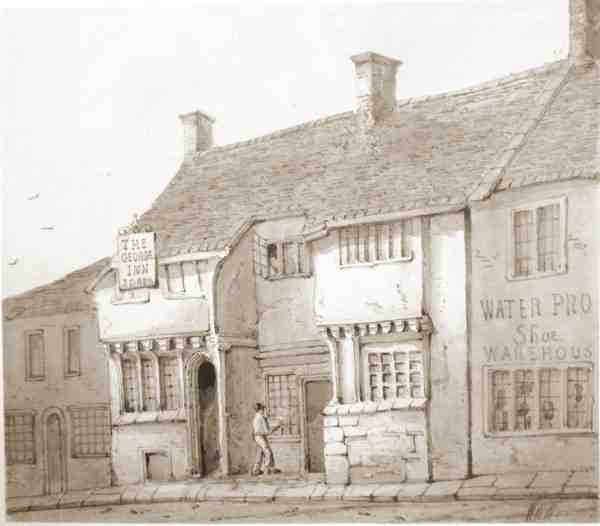
A sketch of the George Inn, drawn in 1847 in pencil and sepia watercolour by William Walter Wheatley (1811-1885). Compared with the later photographs shown below, Wheatley's representation is extremely condensed.
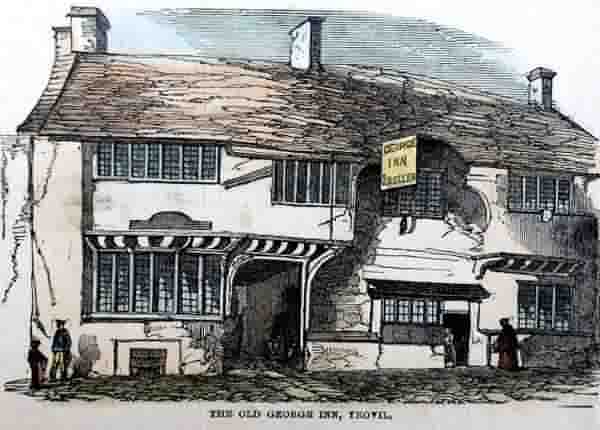
From my
collection
This is an illustration of the George Inn from the Illustrated London News, edition of 4 September 1853 when J Rollen was landlord. The timber framing is here plastered over. Note that at this time Yeovil appears to have been populated by midgets.
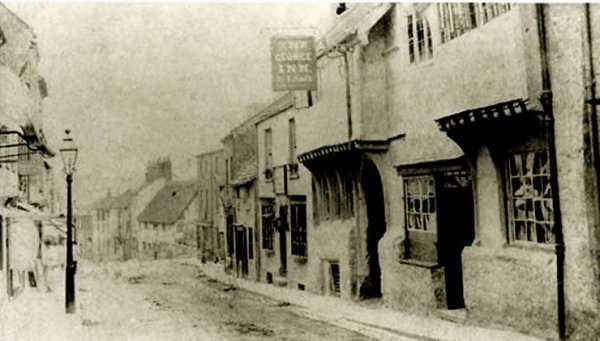
This
photograph
features in my
book "Lost Yeovil"
Probably one of the earliest photographs of the George Inn, this was taken about 1880 when Robert Leach was licensee.
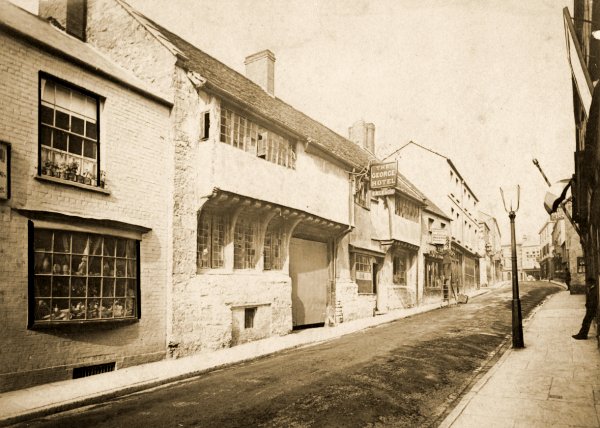
Courtesy of South Somerset Heritage Collection
In this photograph, by Henry Stiby, of the mid-1880s (when Samuel Leach was landlord) the timber framing remains hidden but the name has changed from the George Inn to the George Hotel. The narrow width of the main London to Exeter road, less that twelve feet, is evident in this photograph.
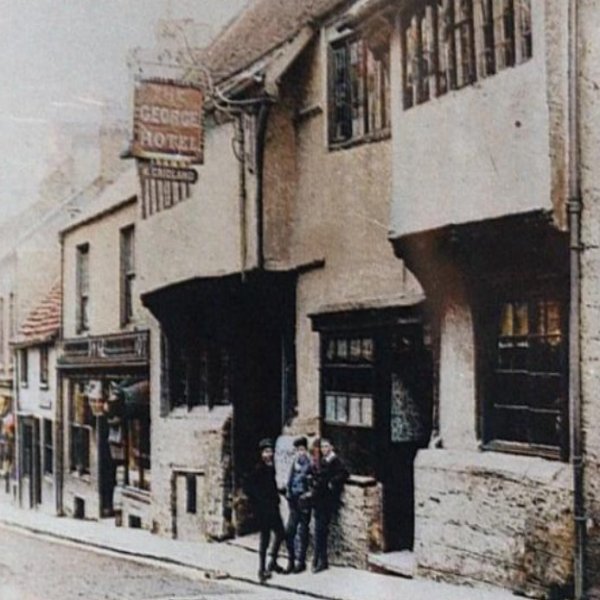
This colourised photograph dates to 1896 when William Cridland was landlord of the George Hotel. Next door was the shop of wood turner and cooper George Dyke.
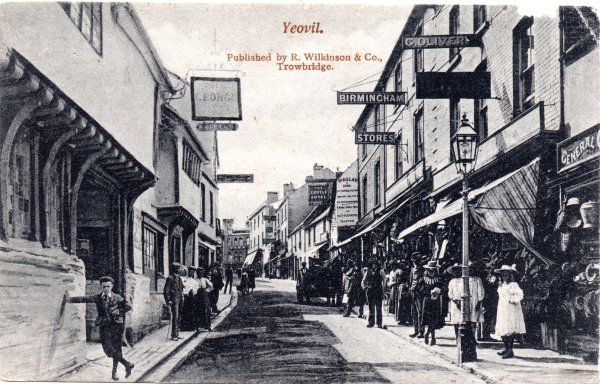
From my
collection
This postcard was posted in 1907 but again the photograph was taken in 1896 or 1897 when the landlord of the George Inn was William Cridland.
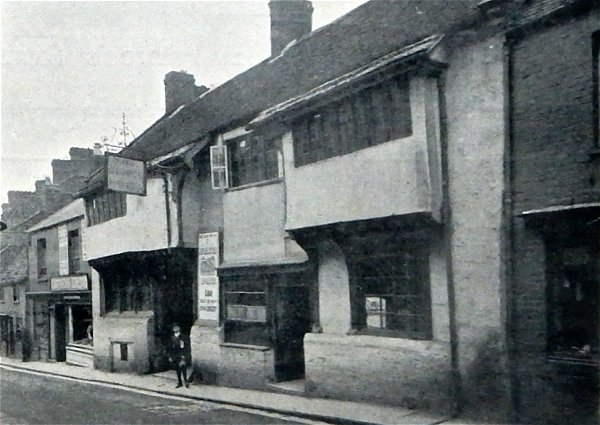
This photograph was taken by Yeovil Photographer Jarratt Beckett and published in his 1897 book "Somerset viewed through a Camera".
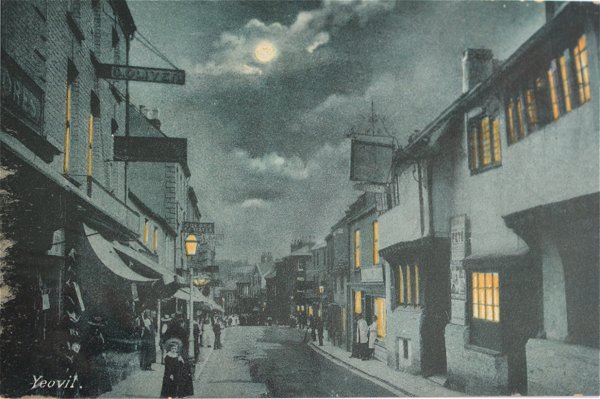
From my
collection
An unusual postcard of the George by night, dating to about 1905.
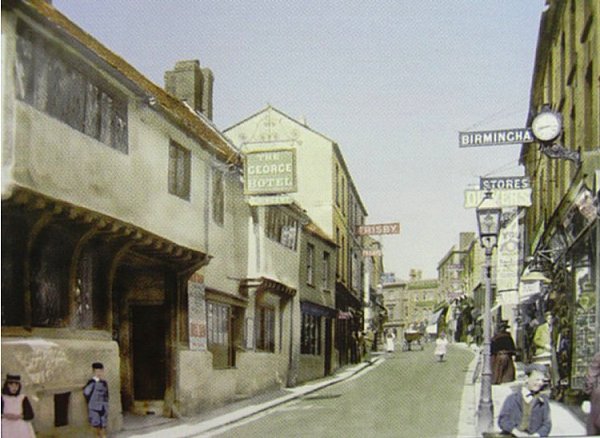
From my
collection
A hand-coloured photograph dating to about 1900 when Louisa Vincent was licensee.
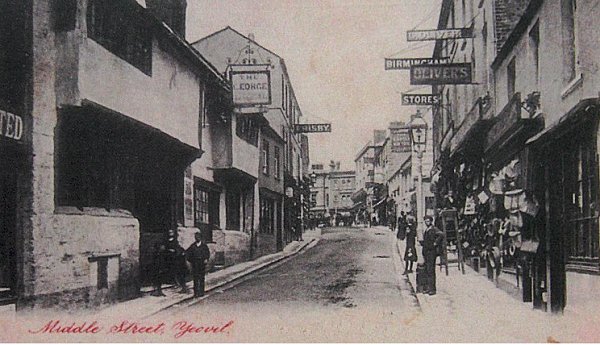
A postcard of Middle Street, featuring the George Hotel, from the following year - 1903.
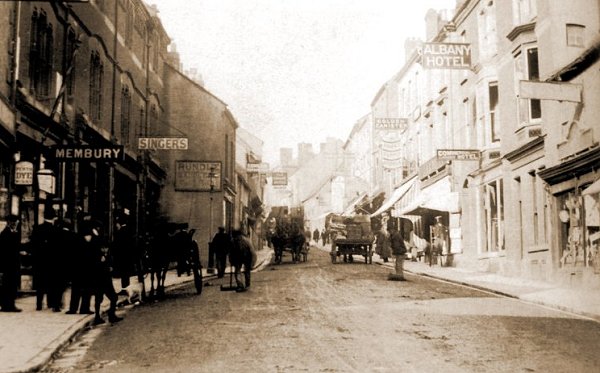
This sepia toned photograph of about 1905 clearly shows the severe narrowing of Middle Street by the George - bearing in mind, of course, that this was the main road from London to the West Country at the time.
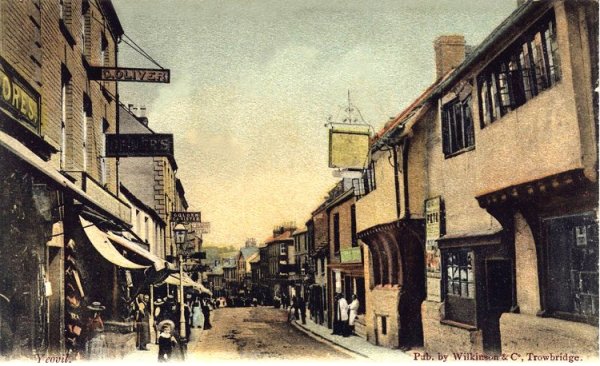
From my
collection
A hand-tinted postcard of the turn of the century shows the timberwork of the George still plastered over.

From my
collection
-
This colourised photograph
features in my
book 'Yeovil From Old Photographs'.
A postcard, sent in 1904, showing a busy Middle Street by the George Hotel (although most, if not all, of the people were added in the photographer's studio).
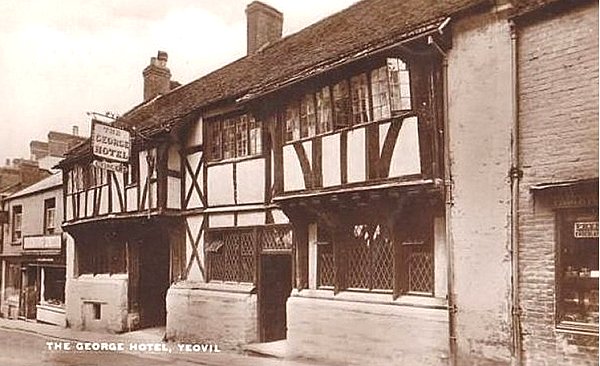
This photograph dates to about 1905 (although as a postcard it was used well into the 1940s) and is the first time that the exposed first floor timberwork is seen exposed during Louisa Vincent's time as licensee.
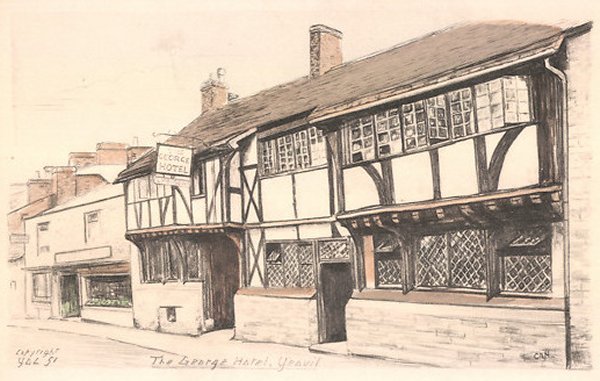
A 1951 sketch of the George Hotel, produced as a postcard.
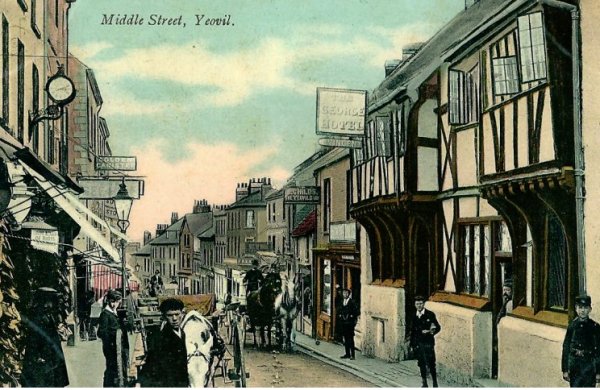
From my
collection
This hand coloured postcard of the George Hotel and Middle Street dates to about 1910 when Louisa Vincent was still the Licensee. The timber framing, missing in the previous photographs, has been exposed. See if you can spot how many of the people or horse and carts were added to the photograph by the photographer in the darkroom. (Clue: all of 'em).
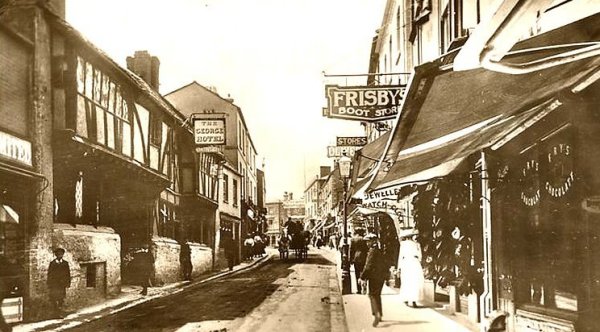
Taken about the same time as the previous hand-coloured postcard, at least this photograph has people that were photographed as part of the scene and not added later.
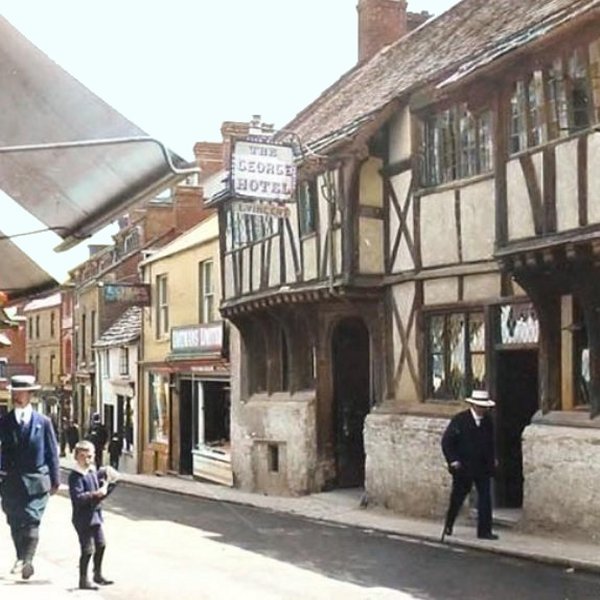
Louisa Vincent was still landlady of the George around 1920 when this colourised photograph was taken.

From my
collection
A postcard, from before 1920, of Middle Street and featuring the George Hotel.
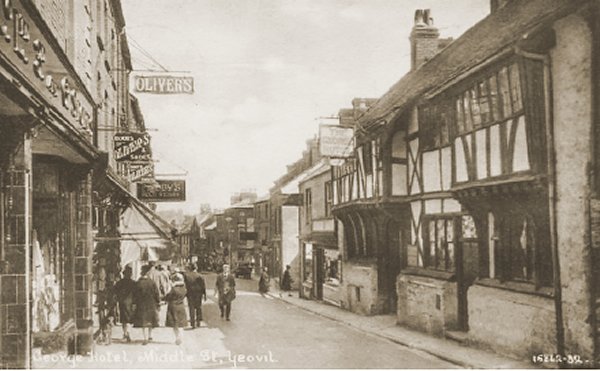
The George seen in a general view of Middle Street in this postcard of 1933.
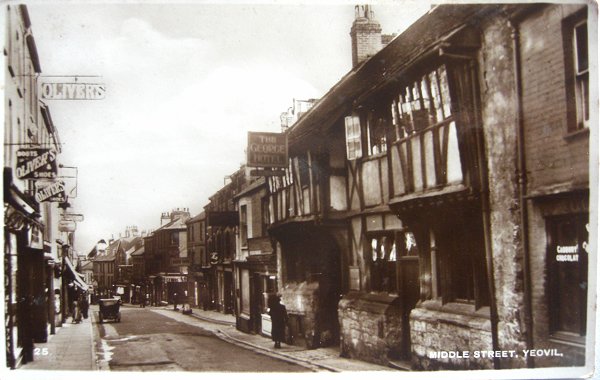
From my
collection
.... and almost exactly the same view in this postcard of 1941.
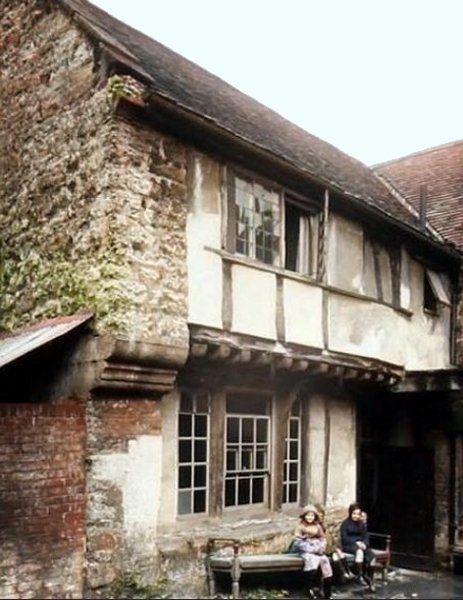
Very few people
would have seen
this side of the
George - the
rear.
Photographed in
the 1940s.
Patricia Smith
remembers
"That's the
bench my sister
and I knelt on
to lean in
through the
window of the
George on the
evening of
Coronation Day
to watch the
repeat on the
hotel's TV....
Just to clarify
which part of
the George is
shown in the
photo: the part
shown with the
children on the
bench was at
right angles to
the main
building which
fronted onto
Middle Street.
You can see part
of the roof of
that in the top
right-hand bit
of the picture."
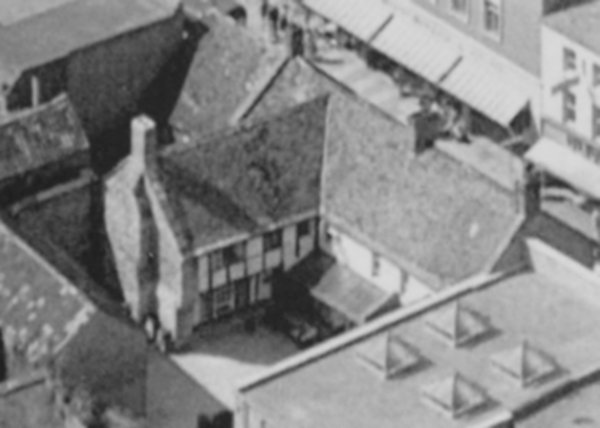
An aerial view of the rear of the George, including the rear yard.
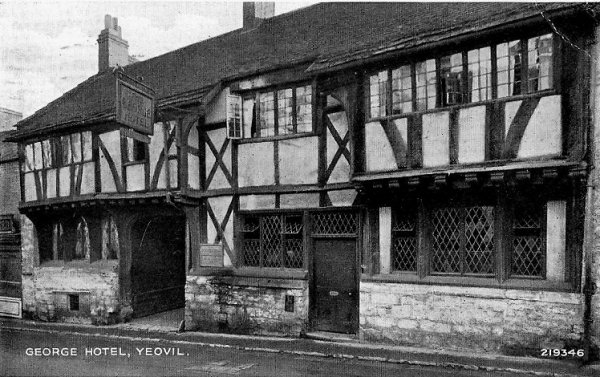
From my
collection
A postcard dated 1949 when SE Cook was licensee.
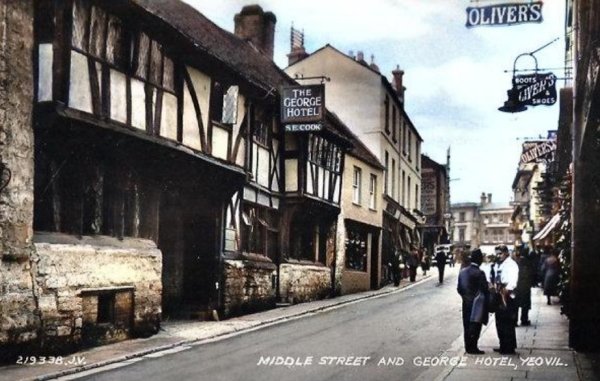
From my
collection
A colourised postcard of about 1955 when SE Cook was licensee.
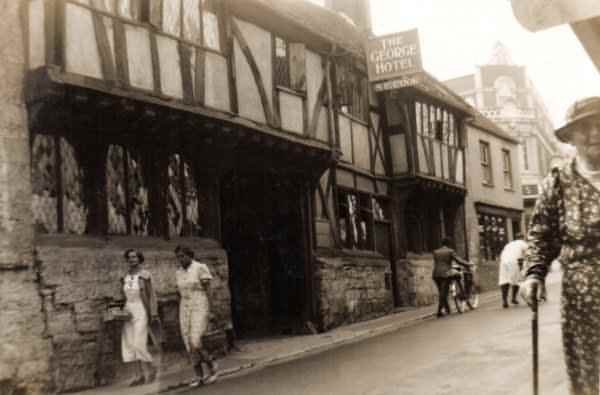
From my
collection
Another postcard of the 1950s when SE Cook was licensee.
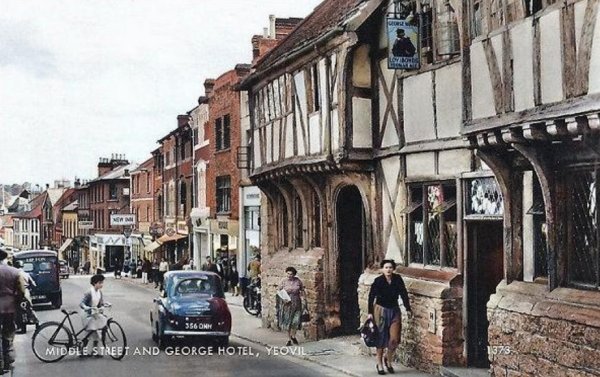
From my
collection
A similar view to the postcard above but some 50 years later. In this colourised postcard dating to about 1960, notice that the George Hotel sign has been replaced and features ales by the Lovibond brewery of Salisbury who purchased the George Hotel in 1920.
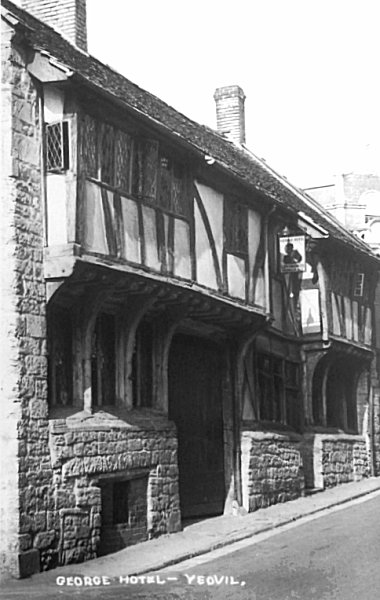
From my
collection
Photographed around 1960 by HA 'Jack' Cooper, with the Lovibond sign at high level.
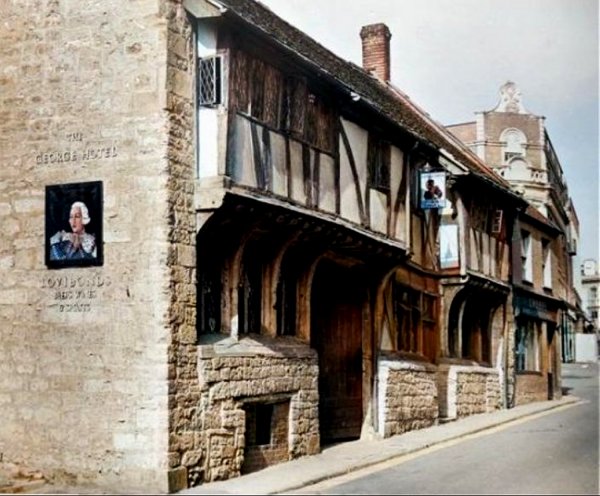
From my
collection
A colourised photograph, again from about 1960, showing the Lovibond signage on the flank wall.
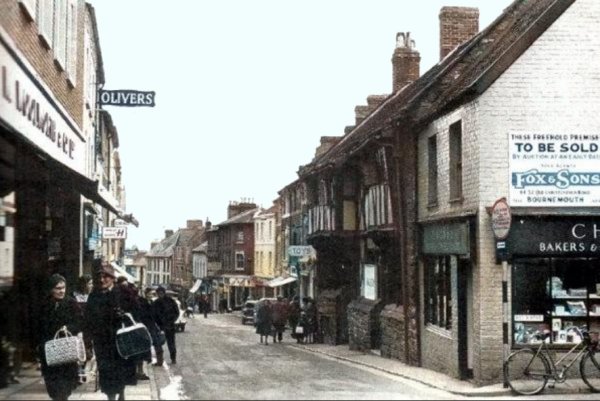
Taken in 1960, this colourised photograph looks down Middle Street. The George was, by now, closed with its signage removed and the 'To Be Sold' sign for the row of premises had been erected. Chubb's bakers and confectioners store was still trading.
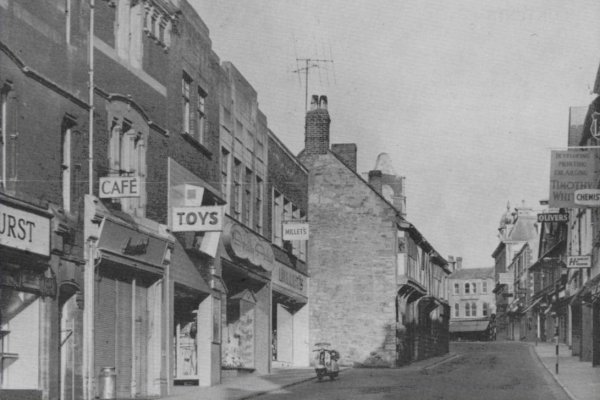
This photograph of the 1960s demonstrates just how far the George projected into the Middle Street streetscape. Some of the other shops will bring back memories - Dewhurst the butchers, the Arundel Cafe (with a milk churn outside), Dorothy Perkins and Milletts outdoors shop with a Lambretta Li150 scooter parked outside. On the other side of the road is Olivers shoe shop and national chain Timothy Whites, dispensing chemist and household stores. The Timothy Whites company was taken over by Boots the Chemist in 1968 although the brand name didn't disappear until 1985.
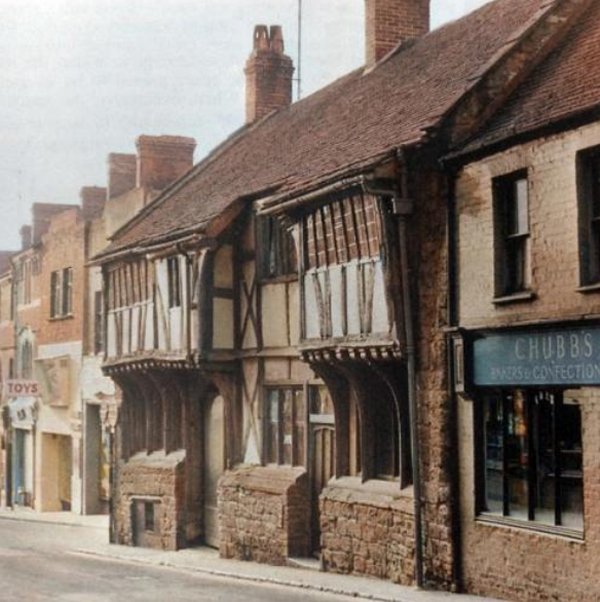
This colourised photograph was taken in 1962, just prior to demolition. The beautiful timberwork supporting the jettied bays is most evident. Chubb's bakers and confectioners store was also closed by this time.
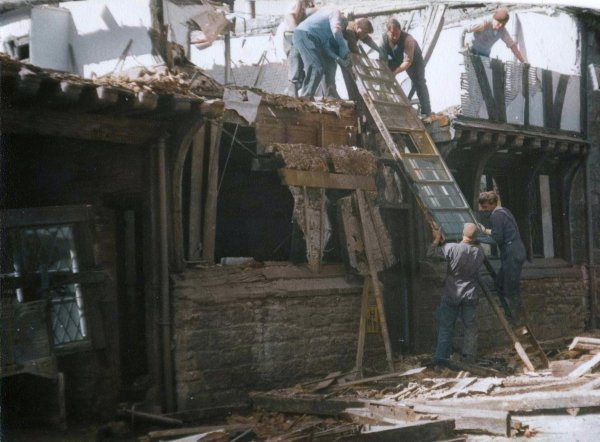
From the Cave
Collection
(colourised),
Courtesy of South Somerset Heritage Collection
.... and during demolition. The windows, as well as other elements, were salvaged; one ended up in the Community Heritage Access Centre and others were rumoured to be reused in a cottage in Dorset.
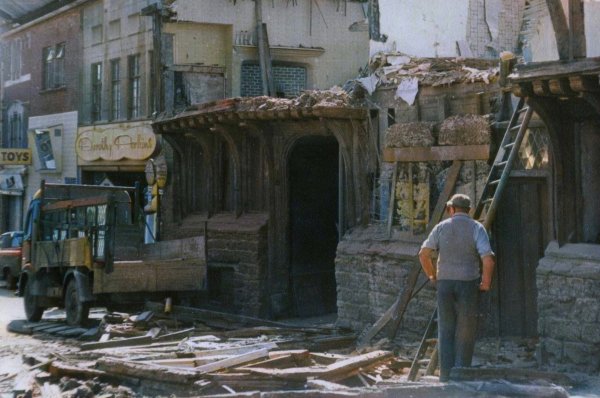
From the Cave
Collection,
Courtesy of South Somerset Heritage Collection
...and another scene of the wanton destruction of Yeovil's oldest, and probably rarest, secular building. And there are still bottles standing on the first floor mantle-piece.
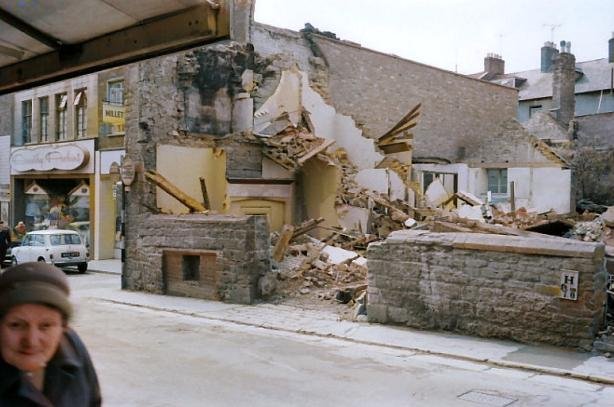
From the Cave
Collection
(colourised),
Courtesy of South Somerset Heritage Collection
Towards the end of demolition the depth of the pub can be appreciated - the back wall is the tall white wall being demolished just left of centre of the photograph while the single storey buildings being demolished behind it are modern.
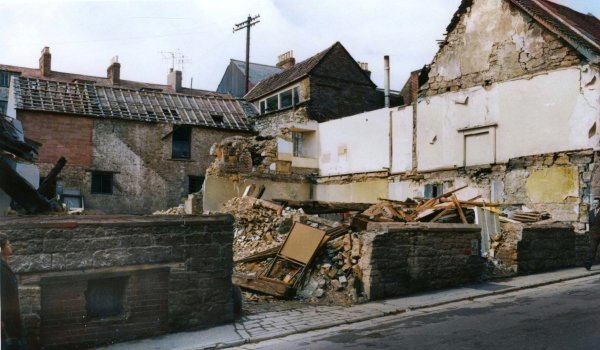
From the Cave
Collection
(colourised),
Courtesy of South Somerset Heritage Collection
This photograph gives a good indication of the depth of the site, but the outbuildings at the rear have yet to be demolished.
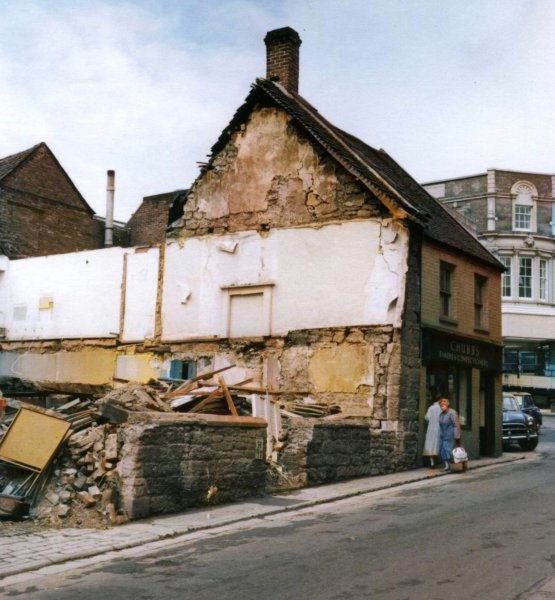
From the Cave
Collection
(colourised),
Courtesy of South Somerset Heritage Collection
This photograph, looking towards Union Street, gives an indication of room heights. Chubb's Bakery would soon also be demolished.
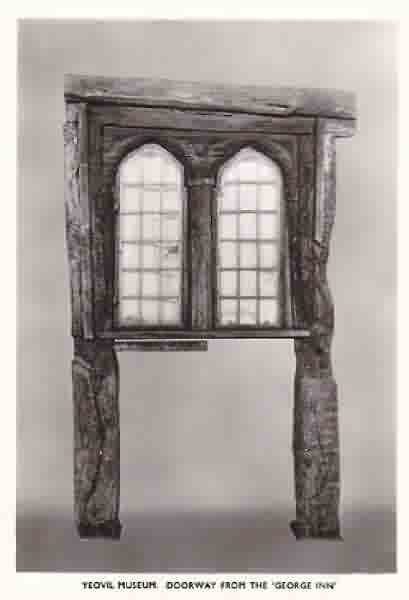
A postcard of one of the last vestiges of the George. This is now safely tucked away in Yeovil's alternative to a proper museum, the Community Heritage Access Centre, so hardly anyone will ever see it again.
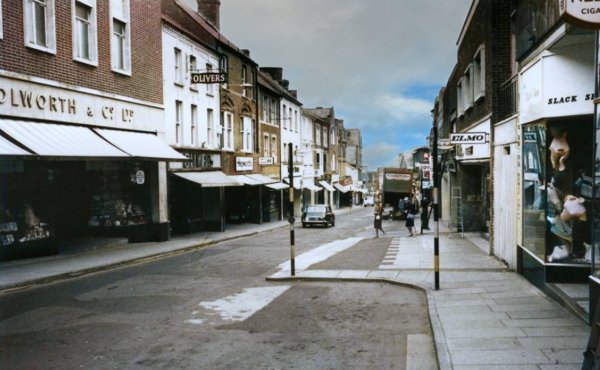
From the Cave
Collection
(colourised),
Courtesy of South Somerset Heritage Collection
And the footprint remains...
So, it was demolished to widen the road but some idiot at the Council forget to realise that they didn't own the land (not much of a surprise there then) so the road couldn't be widened after all. In any event within ten years the road was pedestrianised, so this wonderful 14th century building was, pretty much, wantonly destroyed for nothing.
owners / licensees
The George was owned by the Woborn Almshouse from 1478 until 1920.
Tenants of the building as a private house
1531 - William
Shorte - rent of
14/- per annum
1550 -
Gyles
Hayne (died
1580) - (Lease
dated 1550)
1580-1597 -
Alice Hayne
(widow of Gyles)
1597 - John
Hacker
1600 - Joseph
Hayne
c1610 - Widow
Harrison
1617 - Thomas
Grobham (died
1642)
1621 - Thomas
Grobham
(Woborn
Muniments)
1642 - Anne
Underwood
(Thomas
Grobham's
daughter)
1642 - sub-let
to Robert Butt
Licensees as the
Three Cups
c1643- Robert
Butt was
possibly the
first licensee
"commonly called
the Three Cuppes"
1650 – Robert
Butt (Lease
dated 1650)
1650 - Frederick
Underwood
'called 3 Cuppes,
formerly T
Grobham's'
(Woborn
Muniments)
1668 – James
Markes (Lease
dated 1668)
1677 – James
Markes (Renewal
lease dated
1677)
1698 – James
Markes (Lease)
surrendered 24
May 1705
1705 – Mrs
Dorothy Markes
until at least
1733
1712 - Dorothy
Markes
(Woborn
Muniments)
1727 - 'occupier
of the George,
late 3 Cuppes'
(Woborn
Muniments)
1735 – Jer[emiah]
Hayne for 3
Cuppes (Rate
Book)
1747 – G Hayne
(Woborn
Muniments)
1766 – Widow
Hayne for the
Three Cups (Land
Tax Return SRO
Q/RE1)
Licensees as the
George
1777 – Hugh
Butts - '3 Cups
(or George)'
(Woborn
Muniments)
1777 – Hugh
Butts, a Glover
(Woborn
Almshouse
Account Book)
1781 – Hugh
Butts, occupier
Henry Hewlett
(Land Tax
Returns)
1787 – Hugh
Butts (Land Tax
Returns) listed
as Three Cups
1796 – Mrs
Kitson - for
'Haynes' – she
also rented the
Pall Inn
c1800 - J Rollen
(from name on
drawing above)
1822 – John Cox
(Pigot’s 1822
Directory)
listed as George
1823 – John Cox
(Pigot’s 1823
Directory)
listed as George
1824 – John Cox
(Pigot's 1824
Directory)
1826-32 - Sus.
Kitson
1827 – John
Thomas, tenant
(Land Tax
Returns)
1827 – John
Thomas,
innkeeper (Jury
List) Middle
Street
1828 – John
Thomas;
Proprietor
Susannah Kitson
(Land Tax Return
- SRO Q/RE1)
1830 – John
Thomas (Pigot’s
1830 Directory)
listed as George
1832 – John
Thomas (Woborn
Almshouse
Account Book)
1836 – E Henning
- £45
(Woborn
Muniments)
1839 – John
Brett (Robson’s
1839 Directory)
listed as George
1841 – Sam
Wingrove –
Victualler (1841
Census)
1842 – John
Hurlstone,
tenant
1842 – John
Hurlstone
(Pigot’s 1842-4
Directory)
listed as George
1847 – Mrs
Osmond - £25
1849 – J Holden
- £25
1850 – John
Holden (Hunt &
Co 1850
Directory)
1851 – John
Holden – Inn
Keeper (1851
census)
1852 – John
Holden – Inn
Keeper (Slater’s
1852 Directory)
1852 – J Rollen
(from
Illustrated
London News
drawing above)
1858 – William
Smith - £32
(Woborn
Muniments)
1859 – William
Smith (Harrison,
Hodder & Co 1859
Directory)
1861 – William
Smith – Inn
Keeper (1861
census) pub not
named
1861 – William
Smith (Kelly's
1861 Directory)
listed as George
1862 – William
Smith - £32
(Woborn
Muniments)
1866 – George
Smith (Kelly's
1866 Directory)
1871 – Louisa
Smith –
Innkeeper (1871
census)
1875 – William
Henry Hodges
(1875 Post
Office
Directory)
1875 – William
Henry Hodges
(Kelly's 1875
Directory -
Hotels & Inns)
1879 – Robert
Leach (Whitby's
1879 Yeovil
Almanack
Advertiser)
1880 – Robert
Leach (Whitby's
1880 Yeovil
Almanack
Advertiser)
1881 – Samuel
Harris –
Publican (1881
census) listed
as the George
1881 – Samuel
Harris (Whitby's
1881 Yeovil
Almanack
Advertiser)
1882 – Earle
Vincent £75,
Samuel Harris,
tenant
(Woborn
Muniments)
1885 – SR Leach,
tenant
1889 – Samuel
Leach (Kelly’s
1889 Directory)
listed as George
1891 – Samuel
Leach – Licensed
Victualler (1891
census) listed
as the George.
1893 – Thomas
Delamont,
licensee - Earle
Vincent, owner (Sale
of Vincent's
estate)
1896 – Wm E
Cridland –
Proprietor
(Whitby's Yeovil
Almanack
Advertiser 1896)
George Hotel
1897 – William
Cridland
(Kelly’s 1897
Directory)
listed as George
1898 – J French
- License
transfer
(Borough Petty
Sessions,
October)
1898 – Fred Lee
- License
transferred
(Borough Petty
Sessions,
October)
1901 – Louisa
Vincent – Hotel
Keeper (1901
census) – listed
as the George
Hotel.
1902 – Mrs
Louisa Vincent
(Kelly’s 1902
Directory)
listed as George
Hotel
1911 – Mrs
Vincent (1911
census Summary)
listed as George
Hotel
1914 – Mrs
Louisa Vincent
(Kelly’s 1914
Directory)
listed as George
Hotel
1919 – Louisa
Vincent (Kelly’s
1919 Directory)
listed as George
Hotel
1920 – Purchased
by Lovibond's
Brewery of
Salisbury
1923 – Mrs
Louisa Vincent
(Kelly’s 1923
Directory)
listed as George
1939 – Stanley
Cook (Kelly’s
1939 Directory)
listed as George
PH
1947 – SE Cook
(1947 Yeovil
Directory)
listed as George
1949 – SE Cook
(Kelly’s 1949
Directory)
listed as George
1951 – SE Cook
(1951 Yeovil
Directory)
listed as George
1954 – SE Cook
(1954 Yeovil
Directory)
listed as George
1957 – SE Cook
(1957 Yeovil
Directory)
listed as George
Inn
1960 – SE Cook
(1960 Yeovil
Directory)
listed as George
Inn
Demolished in
1962 but still
listed in the
1965 edition of
the Yeovil
Directory!
documentation
Documentation as a Private House
|
1550 |
Lease for 62 years at 14s. per annum (in Latin). John Dyrdo, custos, John Hacker sen., and John Clothyer, wardens, to Egidius (Gyles) Hayne - Burgage in Pyt Lane between burgage of Gyles Peny on the east, and burgage of John Rodgers on the west. Fine nil. 20 January 3 Edw. VI. Witnesses - Richard Hacker tnt ppoito de ville de Yeville. Endorsed: Gyles Haynefrom Dyrdo for the corporation (ie the Almshouse) this was made for no consideration to Hayne made for 68 years, 3rd Edw. 6. (Woborn Almshouse Muniments No. 108) |
|
1602 |
Lease for 60 years at 14s. per annum. William Grobbyn, custos, Whilliam Phelpes, John Marchaunt, wardens, to Joseph Hayne (occupation erased) - Burgage in Pit Lane between land of Ambrose Locke on the east, and land now held by Gyles Marchaunte on the west. Fine 40s. 16 July 1602. - Endorsed. Signed sealed and delivered in the poresence of Peter Wallis, John Dyer - the lease of my house in Pit Lane. (Woborn Almshouse Muniments No. 131) |
|
1611 |
From Inquisition of 1611 - Lease at 2s.4d. per annum - William Grobham to Rabbish Girdler - burgage and yard in Yeovil - fine 20s. 20 July 1602. Fine stated to be worth 40s. (Woborn Almshouse Muniments No. 131) |
|
1621 |
Lease for three lives, annual rent 16s. Nicholas Patten, custos, Gyles Jennynges, John Hardynge, wardens, to Thomas Grobham, Martha his wife, and Agnes their daughter. Fine 40s. 29 November 1621. Witnesses - Joseph Farre, Tinner; Edw. Ford, George Hacker, Wm. Criendfield. Endorsed: possession taken 27 March 1622. Geo. Hacker, Simon Torr (attornies). (Woborn Almshouse Muniments No. 9) |
|
Documentation as the Three Cups |
|
|
1642 |
Almshouse Lease - "formerly held by Thomas Grobham, deceased, and commonly called The Three Cuppes." |
|
1650 |
Lease for 2 lives for annual rent of 16s. Richard Rocke, custos, George Winsor, John Grobham, wardens, - to Frederick Underwood and Rachell Underwood son and daughter of Joseph Underwood, grocer, of Dorchester, - Burgage in Pit Lane between land of late Ambrose Locke nowq of Thomas Meade on east, and of Lawrence Woodham the elder on west, formerly held by Thomas Grobham, deceased, and now in the tenancy of Robert Butt, commonly called The Three Cuppes, from termination of ?? of Anne, daughter of Thomas Grobham deceased, now wife of Joseph Underwood, to Frederick Underwood for life and then to Rachell Underwood for life. Signed Richard Roche, George Winsor, John Grobham. Fine £14. 7 November 1650. Witnesses - Morgan Hayne, William Daniell, John Roch, George Moore junior. (Woborn Almshouse Muniments No. 37) |
|
1677 |
Lease
for 99
years at
16s. per
annum.
Ambrose
Seward,
custos,
Nathaniell
Cary,
William
Rowe,
wardens,
to James
Markes,
innholder,
of
Yeovil -
Burgage
in Pitt
Lane
between
land of
late
Ambrose
Locke,
deceased,
now of
Ambrose
Seward
on east,
and land
now held
by
Thomas
Seward
on west,
commonly
called
'The
Three
Cupps',
formerly
held by
Thomas
Grobham,
and
lately
by
Robert
Butt
deceased.
- Lives
of James
Markes,
Alice
his
wife,
and
James
their
son.
Fine
£20. -
23
November
1677 (29
Charles
II).
Signed -
Ambrose
Seward,
custos,
Nathaniel
Cary,
William
Rowe,
warden;
Witnesses
John
Hayne,
George
Moore
sen.,
Jam???
Jacob. |
|
1698 |
Lease for 99 years or 3 lives at 16s. per annum. William Harbin, esq., custos, Nathaniel Cary, Jeremiah Hayne, gents, wardens, to James Markes, innholder of Yeovil - Burgage in Pitt Lane, between land of late Ambrose Lock deceased on east, and land late of Thomas Seward on west, commonly called 'The Three Cupps' - Lives of James Markes, Alice his wife, and John their son. Fine £16. 17 December 1698. Signed Wm. Harbin, Jeremiah Hayne, Fran. Carleill. Endorsed James Markes his lease. Surrendered 24 May '05. (N.B. Accounts 1705 - Mr Markes for purchase money £12) (Woborn Almshouse Muniments No. 2) |
|
1777 |
Counterpart
of Lease
for 99
years
for 16s.
per
annum.
Henry
Donn,
gent,
custos,
Ambrose
Seward,
mercer,
warden,
to Hugh
Butts,
glover
of
Yeovil -
Burgage
in Pitt
Lane or
Middle
Street
known as
The
Three
Cupps
between
lands of
G. King
on east,
and land
of
William
Newman
on west,
now in
possession
of H.
Butts
his
undertenant
or
undertenants.
Fine £5.
Duty 2s.
3 July
1777.
Lives of
Elizabeth
wife of
T
Priddle,
Hellena
wife of
G. Cayme,
and Mary
daughter
of Hugh
Butts.
Signed
Hugh
Butts.
Witnesses
-
Daniell
Tinney,
John
Hodges.
(Pencil
Endorsement
'George
Inn')
(Woborn
Almshouse
Muniments
No. 95) |
|
Documentation as the George Inn |
|
|
1856 |
"We must not quit this part of our subject without saying a word about the most ancient house as well as hostelry in the town; we mean the George Inn (formerly the Three Cups Inn). It is worth a pilgrimage to Middle Street to look at it. For centuries it has afforded accommodation to man and horse; and if not as gray as St John's tower, it is nearly as old. There is painful tradition connected with this inn, which may, or may not, be true; but it is said that during the plague which visited this country, some travellers arrived at this inn in a waggon or cart; and that they brought with them the terrible disease. It soon spread over the town, destroying its hundreds, some say thousands; and the rank grass, nourished by the pestilential atmosphere, grew in the street, then a narrow thoroughfare, in which the inn is situated." (Daniel Vickery, 'Sketch of Yeovil' p.47) |